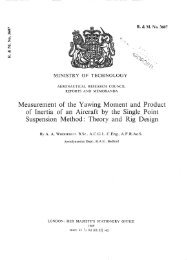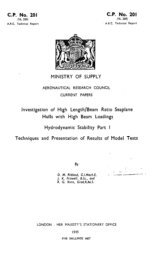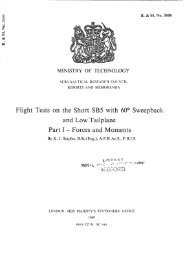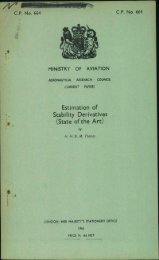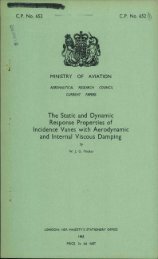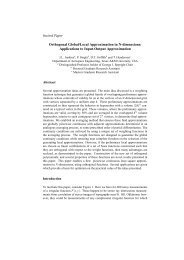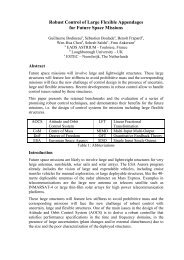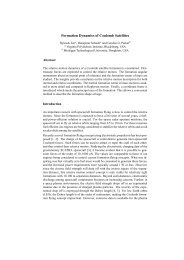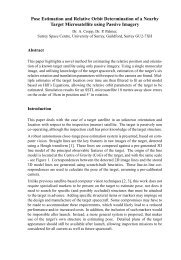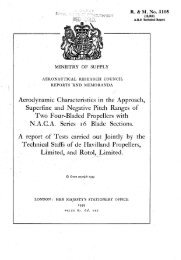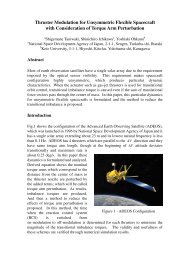The Aerodynamic Characteristics of Flaps
The Aerodynamic Characteristics of Flaps
The Aerodynamic Characteristics of Flaps
You also want an ePaper? Increase the reach of your titles
YUMPU automatically turns print PDFs into web optimized ePapers that Google loves.
Analysis <strong>of</strong> some experimental data has shown that the corresponding increments for plain<br />
flaps on wings <strong>of</strong> thickness <strong>of</strong> about 12 per cent are not appreciably different from those for<br />
split flaps on wings <strong>of</strong> that thickness. If the argument above is accepted, we may expect that the<br />
increments tor plain flaps will not show the variation with wing thickness shown by split flaps.<br />
<strong>The</strong>refore, if is suggested that the curve <strong>of</strong> Fig. 6 for ;~(/3) for a wing thickness <strong>of</strong> 12 per cent<br />
be used for plain flaps on wings <strong>of</strong> all thicknesses within the usual range.<br />
4.1.2. Part-spa~ flaps.--From calculations <strong>of</strong> Hollingdale 16 one can derive the theoretical<br />
ratio <strong>of</strong> the lift coefficient increment <strong>of</strong> a part-span flap <strong>of</strong> any type to the corresponding increment<br />
for a full-span flap. This ratio is shown as a function <strong>of</strong> flap span for various taper ratios<br />
in Fig. 9, and is denoted by Z3(bflb). An analysis <strong>of</strong> experimental data 4 has shown reasonable<br />
agreement between experiment and these theoretical curves. Hence, for part-span flaps<br />
ACL' = ;tl(cdc') ;t2($) Z3(bdb) . . . . . . . . . . . . . (17)<br />
It may be noted that, where a flap has a central cut-out so that the spanwise positions <strong>of</strong> its<br />
inboard and outboard ends are at bil/2 and bi2/2 from the centre-line, respectively, then the<br />
part-span correction factor is<br />
It must be emphasised that the factor 43 applies to all types <strong>of</strong> flaps.<br />
4.2. Pr<strong>of</strong>ile Drag Coefficient Increments.--4.2.1. Full-spa~¢ f/aps.--Proceeding on much the<br />
same lines as in the analysls <strong>of</strong> lift coefficient increments, Young and Hufton ~ assumed that<br />
= . . . . . . . . . . . . . . (is)<br />
where ~ and a~ are functions that were determined from experimental data.<br />
curves for trailing edge split flaps are shown in Fig. 10a and b.<br />
<strong>The</strong> resulting<br />
It will be noted that for these flaps the pr<strong>of</strong>ile drag increment is roughly 1 o 1 sin ~/~ in terms <strong>of</strong><br />
the area <strong>of</strong> the flap. For a discussion <strong>of</strong> the pr<strong>of</strong>ile drag increments <strong>of</strong> split flaps ahead <strong>of</strong> the<br />
trailing edge (see section 11).<br />
<strong>The</strong> data <strong>of</strong> Ref. 39 indicate that the pr<strong>of</strong>ile drag increments <strong>of</strong> plain flaps on wings <strong>of</strong> thickness<br />
<strong>of</strong> about 12 per cent are not quite so large as the corresponding increments <strong>of</strong> split flaps, and they<br />
are reasonably fitted by the function for a 2(/~) for plain flaps shown on Fig. 10b. For the reasons<br />
explained above we may expect little variation <strong>of</strong> these increments with wing thickness, and it<br />
is suggested that the function shown be generally used for plain flaps.<br />
For flaps <strong>of</strong> the Zap or Gouge type in their fully extended position the increment should be<br />
readily calculable from the plain flap case if allowance is made for the chord extension.<br />
4.2.2. Part-spanflafls.--General considerations confirmed by experimental data led Young<br />
and Hufton 4 to conclude that the drag increment <strong>of</strong> a part-span flap <strong>of</strong> any type is proportional<br />
to the area <strong>of</strong> the flapped part <strong>of</strong> the wing. Hence, to determine the increment for a part-span<br />
flap we must multiply the increment for a full-span flap by the ratio <strong>of</strong> the flapped wing area to<br />
the total wing area. <strong>The</strong> latter ratio, denoted by aa(bi/b ), is shown in Fig. 12 as a function <strong>of</strong><br />
flap span for wings <strong>of</strong> various taper ratios. Thus, for a part-span flap<br />
. . . . . . . . . . . . . (19)<br />
If there is a flap cut-out with the inboard and outboard ends given by the spanwise ordinates<br />
biJ2 and bj~./2, respectively, then<br />
- . . . . . . . . . (20)<br />
4.3. Pitching Moment !ncrements.--4.3.i. Full-span flaps.--From an unpunished analysis<br />
<strong>of</strong> the pitching moment increments <strong>of</strong> plain and split flaps by Haile the curves <strong>of</strong> Fig. 13 have<br />
been deduced showing the ratio<br />
ff 1 = -- A C,,,',/A Cr'<br />
as a function <strong>of</strong> flap-chord/wing-chord (effective) for various thickness/chord ratios. A CZ is<br />
11



